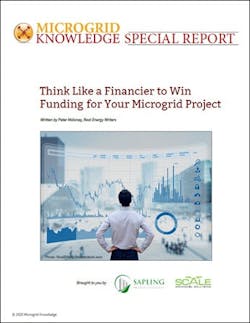This is the first entry in a series courtesy of Sapling Financial Consultants and Scale Microgrid Solutions that shows readers the ins and outs of microgrid project funding. Find out what your potential financiers are thinking.
Get the full report.
Mind the gap
It’s far easier to finance a microgrid today than it was just a few years ago thanks to new financing mechanisms and a greater understanding of the technology by investors. Still, some great microgrid projects do not see the light of day because of the gap between a developer’s vision and a financier’s scrutiny.
Developers, sponsors and engineers who work on microgrid projects think in terms of equipment, configurations and benefits, such as resiliency and sustainability. As much as they may agree with the policy goals and beneficial aspects of a microgrid, financiers bring a different point of view to a project. They look at the bottom line and think in terms such as internal rate of return, risk-reward ratios and debt-service coverage ratios. The gap between the two points of view often creates a gulf into which a microgrid project can fall and never reappear into the light of day.
It is possible to bridge the gap, however, by taking the time to understand what financiers look for in a microgrid project.
This white paper lays out how investors and other financiers think about energy projects. The aim is to help move a microgrid from the drawing board to reality by preparing engineering firms, developers and project sponsors to think like those in the lending community.
For the purposes of this paper, we can define a microgrid as an electric power system that generates enough energy to meet or exceed loads within a defined geographical boundary. A microgrid may or may not operate within a utility grid, but if it does, it has the ability to “island,” i.e., to disconnect from the surrounding grid and operate autonomously to ride out a blackout or other adverse conditions.
The ability to operate as an island is a distinguishing characteristic of a microgrid. It is also often the source of some of a microgrid’s chief benefits. Being able to island during a storm or an emergency enables a microgrid to keep the electricity flowing to critical municipal facilities, hospitals, data centers, grocery stores,
gas stations and others that provide services society depends upon. The reliable power offered by microgrids is also important to businesses that lose products, manufacturing capabilities or sales during power outages.
As laudable and valuable as microgrid benefits may be, from the perspective of some financiers, they also present challenges. In their view, islanding requires complicated technology that is unfamiliar to them compared to conventional energy equipment, such as gas turbines, which have long track records both in terms of operations and as part of successfully financed deals.
So, while the ability to island enables a microgrid to provide resilience, not all financiers understand how to turn energy resilience into a source of cash flow. Because power outages are sporadic and unpredictable, financiers do not always know how to assign a financial value to resilience, although a great deal of analytical work on the concept has been conducted recently.
While microgrids have more avenues for financing than ever before, the problem remains that microgrid developers and the financial world don’t always speak the same language. What do project sponsors need to know—and do—to create a proposal that will get a nod from investors?
Getting to bankable
Developers must first understand the obstacles they face. Microgrids are complex and have many moving parts. A single microgrid could include one or two generators, such as solar panels and a gas turbine, an energy storage device, and a variety of controls to monitor grid conditions, balance loads, and connect and disconnect from the grid. This technological complexity may add complexity from a financing point of view.
Over the past several decades, financiers have developed financial mechanisms as the power market has undergone changes brought about by deregulation, decentralization and the proliferation of renewable energy resources.
Compared with a microgrid, however, those projects require relatively simple financing structures because they are anchored by a stream of payments for energy and green attributes produced. A microgrid could be financed the same way, but that would not account for, or value, many of the abilities and benefits of a microgrid.
Developers and financiers alike face the challenge of attaching monetary values to microgrid attributes in order to create value streams. If the costs of a microgrid are not offset by a predictable value stream on the revenue side of the ledger, it will be more difficult to finance and could become unbankable. Microgrid sponsors should review these obstacles before they approach financiers for financing.
Government agencies and industry players, in an effort to stimulate emerging technologies, have often promoted efforts to standardize project design as well as contractual arrangements so as to attract financing.
In addition to matching a microgrid’s technological attributes and operational benefits with monetary value streams, sponsors should be aware that financiers view microgrids as relatively untested. Many in the microgrid industry may argue this point, but nonetheless, it’s a reality they may face when seeking financing. There are several aspects of this status that need to be considered.
Financiers lend money based on projections into the future. The more certainty that can be associated with those projections, the higher the likelihood of securing funding and securing it at better terms.
Financiers may see microgrids as new technology. Individual components, such as solar panels or gas turbines, may not be new but when configured into a single project they constitute a new entity. Financiers may require additional data to support the operational claims of microgrids. In addition, some of the components, such as microgrid controllers, are, indeed, new technology and financiers may seek more operational history to demonstrate their viability.
These track record concerns are compounded by the fact that microgrids to date have been built to meet specific requirements. A microgrid project at an urban university that is designed to provide power and heat for campus buildings and be a test bed for electric vehicle charging stations will have a very different configuration than a microgrid in a rural setting designed to provide backup generation for public safety and health functions during emergencies.
Another key consideration for financiers is the creditworthiness of project participants. This applies across the board from technology to off-takers. Financiers look for projects with equipment from known and trusted vendors that will be in business if a warranty needs to be invoked.
Revenue Streams
The greater number of moving parts in a microgrid can be viewed as a liability by financiers, especially those not familiar with the asset class, but the complexity of a microgrid also creates opportunities for a wider variety of potential revenue streams.
In addition to being able to supply energy under a PPA, a microgrid’s ability to multitask can make it eligible to receive payments from wholesale power markets for ancillary services, such as capacity, voltage control or frequency regulation.
Microgrids, especially those that incorporate energy storage, can also provide benefits by reducing demand. In some locations and jurisdictions, a microgrid can create value for the sponsor or host by reducing demand charges or time shifting load. Innovative financial structures can incorporate those savings into revenue streams for microgrid project funding.
Capital Stack
That is important for a sponsor to understand when considering ownership structures and different tiers of capital— what financiers call the capital stack. Financiers have devised structures that allow tax credits to flow to other entities within the project structure. In many solar projects, financial institutions that can use, or monetize, tax credits share ownership of the project until the tax credits expire, or a target return is met, at which point ownership reverts from the tax equity investor back to the sponsor.
Risk Allocation
The appetites of the various parties in any financial arrangement are largely a function of risk appetite, which determines the risk allocation of a project. One of the largest risks in any energy project is fuel supply and price risk. Financiers have devised a number of tools to hedge the risk, such as options and swaps to offset the volatility of fuel costs. In many cases, the best financial outcome requires the customer to procure and take the risk of fuel costs. Because the marginal cost of grid delivered electricity is often highly correlated to natural gas prices, the customer should be indifferent to taking this risk.
Ownership
Ownership has a tight function with the already mentioned factors. If a party does not have tax appetite, they are less likely to take ownership of a project in which an ITC plays a key role in financing. Developers often shy away from a large ownership stake. They prefer to “keep their powder dry,” that is, preserve their capital to develop the next project. That said, financiers often prefer to see a developer show they have “skin in the game” by retaining an equity stake in a project. Strategic investors, on the other hand, often prefer an equity stake.
Download the full report, “Think Like a Financier to Win Funding for Your Microgrid Project,” courtesy of Scale Microgrid Solutions and Sapling Financial Consultants, to learn more about how investors and other financiers evaluate energy projects.







